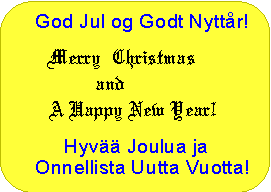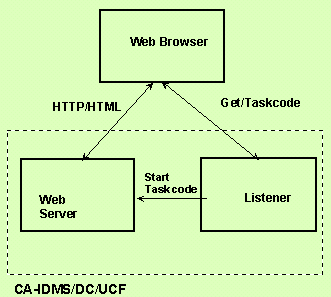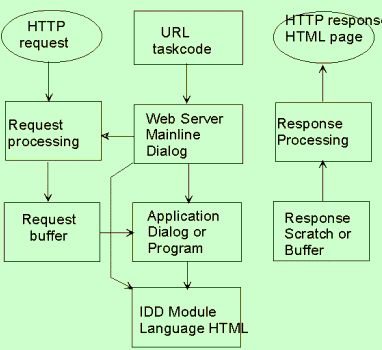| Vol 6.4 Technical Information for CA-IDMSâ Users December 1997 |
12.01 9707 VM/ESA Tape is ReleasedCA-IDMS Release 12.0 VM/ESA 9707 Apar Tape has been released. See PIB # LI23444 for details.Product: IDMS Release: 12.0 Solution #: 3776 CMS Subject: CA-IDMS VM 12.01 APAR Tape, Genlevel C09707DBAA0, Volser A97176 Remember to upgrade to 9607 VM apar tape prior to this. PIB # LI18638 Product: IDMS Release: 12.0 Solution #: 3752 CMS. CA-IDMS VM 12.01 APAR Tape, Genlevel C09607DBAA0, Volser A96183 12.01 9707 VSE Tape is ReleasedCA-IDMS Release 12.0 VSE 9707 Apar Tape has been released. See PIB # LI24357 for details.Product: IDMS Release: 12.0 Solution #: 3795 DOS CA-IDMS VSE 12.01 APAR Tape Genlevel C09707DWAA0 12.01 9707 MVS Tape is ReleasedCA-IDMS Release 12.0 MVS 9707 Apar Tape has been released. See PIB # LI20347 for details. Product: IDMS Release: 12.0 Solution #: 3754 OS CA-IDMS MVS 12.01 Maintenance TapeGenlevel C09707DOAM0, Volser GJ9707 14.0 9610 MVS Tools Tape is ReleasedPIB # LI10180 Product: IDMS Release: 14.0 Solution #: 23 OSNote that Release 14.0 MVS Client must also user Tools at the 14.0 Level. |
 IDMS/SQL News on the WebVisit IDMS/SQL News at http://geocities.datacellar.net/idmssql/ email address: idmssql@geocities.com attn: IDMS/SQL Information User AssociationHome Page is http://www.iuassn.com Join IUA, membership has its advantages and is free.D |
IDMS Client Visits CA IslandiaSenior Managers and IDMS DBA from an Oslo IDMS client, had a strategic meeting with Russ Artzt, Executive Vice President R&D Computer Associates, at CA Headquarters in Islandia, in October 1997. Judy Kruntorad and Ken Reiff, both from CA-IDMS Development Center, Westwood, were also present in the meeting.Stop Press: 14.0 Maint Tape?The one and only tape for R14.0 is 9610 Tape.The maintenance tape for MVS will be released only after 14.0 GA tape for VSE, VM, BS2000 and MSP are released. Latest info shows that MVS maint tape is under QA. u |
Your Contribution!- The EditorThis is your newsletter! So your contribution is essential. Articles can be sent in the following languages at the moment : Finnish, Swedish, Danish, Norwegian, Dutch, German, French, Spanish, Italian and Flemish, and ADS/SQL(!) to idmssql@geocities.com. And if you don't know any of the above, English can be used! SQL Quickref on the WebThe new R14.0 SQL Quickreference is available on the Web at Visit Scandinavian Corner at http://geocities.datacellar.net/idmssql/scand1.htm Release 14.0 Problems at http://geocities.datacellar.net/idmssql/r14.htm |
A Potpourri of Information:
Technical and not so technical
|
Copy IDMS Record and COBOL IDMSDMLC pre-processor can copy a record description from the dictionary to the COBOL program. For subschema records, normally this is automatic. But if you copy a record which is part of a schema and the COBOL program is not using that schema in the schema section, then the copy fails with the message: DMLC 00008 01 COPY IDMS RECORD TEST1 VERSION 1. E DML068 Record Not Found In Dictionary For Given Subschema, Language, Or Mode In fact, the record do exist, but is owned by a schema. The problem can be overcome by creating a synonym for the record, and copying the synonym version number in the copy statement. So the following works.
PROGRAM-ID. TEST1.
AUTHOR. DMLC TEST
ENVIRONMENT DIVISION.
DATA DIVISION.
WORKING-STORAGE SECTION.
01 I PIC S9(8) COMP.
*01 COPY IDMS RECORD TEST1 VERSION 2.
|
01 TEST1.
02 X1 PIC X(2).
02 I1 PIC 9999 COMP
VALUE 0.
02 WS-DBNAME PIC X(8).
02 X2 PIC X(2).
PROCEDURE DIVISION.
0-HOVED SECTION.
Also the keyword 'RECORD' is optional in the COPY statement.
ADD RECORD NAME IS TEST1 VERSION IS 1
RECORD LENGTH IS 14
PUBLIC ACCESS IS ALLOWED FOR ALL
RECORD NAME SYNONYM IS TEST1 VERSION 1
COPIED INTO SCHEMA GMT1 VERSION 1
RECORD NAME SYNONYM IS TEST1 VERSION 2
COPIED INTO PROGRAM TEST1 VERSION 1.
RECORD ELEMENT IS X1 VERSION 1
....
Some may point out that even the first one worked in 10.2. Yes, there was loophole in 10.2, by which the copy of a schema owned record did work! But this has been closed in 12.0 and the only way is to create synonym and code the version number in the copy statement. u |
SQL in Practice : How to do Corner In This Issue To The Top
DML/SQL Deadlock- Oslo dispatch When you mix DML and SQL in the same application thread it works but there are possibilities of deadlock, if both the dialogs are accessing the same network database. We take some simple cases to illustrate the point.
Case1. DML read only dialog links to SQL update dialog. It works if RETRIEVAL NOLOCK set for DDLG47. MOD PROCESS IS PDLG47-RP1 VERSION IS 1
MODULE SOURCE FOLLOWS
MOVE '8' TO DEPT-ID-0410.
OBTAIN CALC DEPARTMENT
ALLOWING (DB-ANY-ERROR).
IF (DB-ANY-ERROR) DISPLAY
TEXT 'OBTAIN DEPT FAILED'.
LINK TO 'DDLG48'.
DISPLAY MSG TEXT
'HERE WER ARE BACK FROM DDLG48'.
ADD PROCESS NAME IS PDLG48-PM VERSION IS 1
USED BY PROGRAM DDLG48 VERSION 1
TEXT IS PREMAP
MODULE SOURCE FOLLOWS
¤ SQL DIALOG IN UPDATE MODE
EXEC SQL
UPDATE EMPNET.DEPARTMENT
SET DEPT_NAME_0410 ='UPDATE FROM DDLG48'
WHERE DEPT_ID_0410 = 8
END-EXEC.
IF SQLCODE NE 0 DISPLAY MSG TEXT
'SQL UPDATE FAIL'.
RETURN.
Case 2: The same case as above, but the dialog DLG47 generated with RETRIEVAL LOCK. You get deadlock immediately! DC001000 T13 T:0000388 ADS2 P:DDLG48 C:DEAD WAITING ON R:LMGR LK 00000000 0125A408 DC001002 T13 T:0000388 ADS2 P:DDLG48 C:DEAD DEADLOCKED ON R:LMGR LK 00000000 0125A408OLQ confirms that the DBKEY 125A408 (75172:8) belongs to the DEPARTMENT Record with calc=8. |
Case 3. DML protected update dialog links to SQL update dialog. The second dialog will deadlock and abend, because of area locks set by dialog 1. MOD PROCESS IS PDLG47-RP1 VERSION IS 1 READY USAGE-MODE IS PROTECTED UPDATE. MOVE '5200' TO DEPT-ID-0410. OBTAIN CALC DEPARTMENT ALLOWING (DB-ANY-ERROR). LINK TO 'DDLG48'. DISPLAY MSG TEXT 'HERE WE ARE'. DC001000 T13 T:0000244 ADS2 P:DDLG48 C:DEAD WAITING ON R:LMGR LK 00008000 0001258F DC001002 T13 T:0000244 ADS2 P:DDLG48 C:DEAD DEADLOCKED ON R:LMGR LK 00008000 0001258FOptionally, dialog 48 can snap the SQLCA which will show the error as 0378 (area wait deadlock). Case 4. DML shared update dialog links to SQL update dialog.This works if the records accessed are different in each dialog. But will deadlock if the second dialog tries to update a record which is current in the first dialog (even with RETRIEVAL NOLOCK). The reason being, record locks are still maintained for the current of RU in update mode.The log message will indicate a record lock: MOD PROCESS NAME IS PDLG47-RP1 VERSION IS 1 READY USAGE-MODE IS UPDATE. (shared) the rest of code same as in Case 1. DC001000 T13 T:000251 ADS2 P:DDLG48 C:DEAD WAITING ON R:LMGR LK 00000000 0125A408 DC001002 T13 T:000251 ADS2 P:DDLG48 C:DEAD DEADLOCKED ON R:LMGR LK 00000000 0125A408 If we snap SQLCA in DDLG48 we get, an explicit message:
Case 5. DML read only dialog links to SQL Update dialog. But the subschema used has hardcoded usage-mode which is update. The result will be deadlock again. There can be other scenarios, where an SQL dialog is repeatedly called from a DML dialog. There is even possibility of a subroutine dialog deadlocking itself. Such a case is discussed in IDMS/SQL News 5.4 (Dec 96)
Note: The sysgen RETRIEVAL NOLOCK tells the system whether or not to keep locks when areas are readied in SHARED RETRIEVAL mode. If no ready mode is specified, default for DML access is SHARED RETRIEVAL, which will take advantage of NOLOCK; This can be overriden at dialog level at compilation time. |
In This Issue To The Top
Crossfire:
|
Communication is an area which is vital to the world of computers. Computer centers are no longer situated in just a 'building'. In fact there are no computer centers as such; what we have is a network of computers. Very often the 'terminal user' does n't even know the location of the machine! If you have a high-speed link (with or without satellite), it is quite possible that one sitting in (say) the island of Fiji has a better response time than a local user with slow link, against a machine in New York! [A colleague quotes from real life that this is true. He had an experience where the time taken for a 3270 data stream to travel from USA to Oslo via Satellite was 0.5 seconds and the time delay in the local LAN was 1 second!]
Internet Issue If this is the case with normal computers then one can imagine the importance of networking and communications in the age of Internet! The whole Internet is heavily dependent on high speed communications! But we see that many HTML pages are unnecessarily crowded with graphic images! The text content might be about 20-30 K, but each GIF/JPEG image might be about 5-20K. So a lavish usage of images increases the size of a normal 20-50K text page to anywhere between 100 to 200K! If one is really looking at an image this is understandable. But
there is no justification for 'image crowded' menus. Some home pages
makes sense only if you activate the images on the browser.
eMAIL Problem
Recently I came across an eMAIL problem. It started like this. I got a mail from one of my EDP friends. |
But I could not read the attachment which was in Word format, and I did n't have word at home! I took the document to office and solved the problem.Then I had to convert the simple message to ASCII to transfer to my home PC. During this process I noticed one thing: The size of the one page Word document was 18 K whereas the ASCII equivalent was only 987 bytes!
This was enormous size for a simple document!. One of my work colleagues said that Word doc has the formatting information, and that makes it a little larger. I converted the same word document to another Windows based word processor with exactly the same fonts - the size was only 4K! So the sizes are
Word95.doc - 18K Textor with fonts - 4K ASCII - 987 bytes Word 97 Shock! While I was trying to find a meaningful explanation or excuse for the size of the above Word document, there comes another shock! A friend sent me another document. The document was in Word97 format. As usual I took it to office to read. Well, the Word95 in my office PC could not read it at all! I had to take it to another colleague to read the document. Having seen the document size (96K) I thought it might be a big one. But when we converted it to the Word95 format the size was only 14K. And in HTML form it was just 4 K! And in printed form it was less than 2 pages!
Not Nice at all! PC products seem to think that they have infinite storage, CPU and network at their disposal! There are at least two issues at stake here.
|
Well, in my experience even a a little older version of Word (Word95) could not read it at all, not to talk about the fonts. And a document (letter or article) should only contain normal fonts like Time Roman, Arial etc. orb their cousins. Fancy fonts are only good for graphical presentations.
Now we come to the more important point. In both the above cases, the document I was expecting could have been embedded in ASCII form in the body of the letter itself (Ms Exchange, Eudora etc). In the second case, the whole letter in ASCII form was less than 5K! But using Word97 for the attachment it came to 97K!
5K vs 97K
is the communication equation! Almost 20 times! Communication cost for upload and download is high! It jams the network more! Imagine when millions of people are sending letters like this and overloading the communication network with no apparent benefit! When Microsoft encourages its MS Exchange users to directly embed Word documents in eMAIL, they don't seem to think of the communication cost at all!
Formatted or Not ?
The issue can be easily settled by asking a question: Do you want to send a formatted document or not!
Is ASCII enough? Then at least for those cases, there is no reason to transmit Word formatting information.
In a general case, it will be better that Word doesn't embed general fonts etc. in the document. Afterall, it is a document and not a graphical sales presentation! How many non-standard fonts do you use in a simple document? |
|
Product Flash:
VEGASOFT proudly presents: VG-IDMS/Web Server- Onni Kukkonen, Vegasoft Oy, Helsinki
Version 1 Release 0 of VEGA-90's Web Server utilizes direct TCP/IP connection between a Web browser and an IDMS application
|
The Web Server supports both static and dynamic HTML pages. Static HTML pages are stored as IDD modules with language HTML. Dynamic pages are created by applications. Functions to extract query variables and to create HTML pages are available. Conversion between EBCDIC and browser character sets is performed using a site specific conversion table. Character encodings (%xx) can be used in query variable values.

An HTML page can contain JAVA Scripts, JAVA Applets as well as Active-X components. Those components (like JAVA Scripts) that can be embedded into an HTML page using text format can be stored in IDD. The non-text format components (like JAVA Applets and graphic images) referred in an HTML page must be saved in non-IDMS environment. The Basic authentication scheme is available for user/password validation with optional IDMS signon (signon is supported in IDMS release 12 and above). The Web Server is implemented using VEGA-90's TCP/IP Sockets API.
Details see Vegasoft Oy at http://www.vegasoft.com u |
SQL Guidelines at IMC'97Session: I2460SR, CA-IDMS SQL Performance & Tuning, at IMC CA-World'97 gives some guidelines on SQL usage in CA-IDMS environment.Guidelines on SQL access against non-SQL database is good. Guidelines on SQL databases are not specific enough. And out of 31, just one slide has been devoted to IDMS/Server (ODBC) access, which is a heavily used feature among many clients! At the same time, 10 out of 31 slides are talking about CA-OpenIngres Enterprise access! Who in the world is using Ingres Gateway against IDMS today? We feel that the mainframe SQL guidelines are vital, and cannot be substituted by marketing material or lectures on unused products/features. |
Doc update for 14.0/SQL- TCC/Technical Support DISPLAY CONSTRAINT doesn't seem to work at the moment. DISPLAY CONSTRAINT
EMP_BENEFITS;
*+Status=1 SQLSTATE=01600
*+E DC601014 CONSTRAINT IS
NOTIN DICTIONARY
But the constraint do exist:
DIS SCHEMA DEMOEMPL
ALL WITH CONSTRAINTS
*+Status=0 SQLSTATE=00000
*+CREATE SCHEMA DEMOEMPL;
*+CREATE CONSTRAINT
EMP_BENEFITS; ....
Latest from CA, indicates that the development has uncovered an oversight here, and a correction and a documentation update are on the way. |
Just One more!
Water FactsEvery day, 15-20,000 people die from a direct or indirect consequence of polluted water or lack of water. At the same time, in 6 months, a leaky toilet can waste 170,000 liters of water. [Time]CA-IDMS/DB,CA-IDMS/DC and CA-ADS are registered trademarks of Computer Associates International Inc. CICS, IMS-DB/DC, VSAM and DB2 are registered trademarks of International Business Machines Corporation. Technical examples are only guidelines. Opinion expressed are those of the authors and do not represent the views of IDMS Clients, Computer Associates or Support Personnel. Permission is hereby granted to use or reproduce the info. * IDMS/SQL is not a CA publication * home page at: http://geocities.datacellar.net/idmssql/ email:idmssql@geocities.com Published on behalf of IDMS WatchDog Group Oslo-Helsinki for free distribution among IDMS users, clients and consultants Worldwide. |